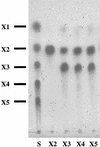Xylanase and acetyl xylan esterase activities of XynA, a key subunit of the Clostridium cellulovorans cellulosome for xylan degradation
- PMID: 12450866
- PMCID: PMC134393
- DOI: 10.1128/AEM.68.12.6399-6402.2002
Xylanase and acetyl xylan esterase activities of XynA, a key subunit of the Clostridium cellulovorans cellulosome for xylan degradation
Abstract
The Clostridium cellulovorans xynA gene encodes the cellulosomal endo-1,4-beta-xylanase XynA, which consists of a family 11 glycoside hydrolase catalytic domain (CD), a dockerin domain, and a NodB domain. The recombinant acetyl xylan esterase (rNodB) encoded by the NodB domain exhibited broad substrate specificity and released acetate not only from acetylated xylan but also from other acetylated substrates. rNodB acted synergistically with the xylanase CD of XynA for hydrolysis of acetylated xylan. Immunological analyses revealed that XynA corresponds to a major xylanase in the cellulosomal fraction. These results indicate that XynA is a key enzymatic subunit for xylan degradation in C. cellulovorans.
Figures



References
-
- Doi, R. H., and Y. Tamaru. 2001. The Clostridium cellulovorans cellulosome: an enzyme complex with plant cell wall degrading activity. Chem. Rec. 1:24-32. - PubMed
-
- Fernandes, A. C., C. M. G. A. Fontes, H. J. Gilbert, G. P. Hazlewood, T. H. Fernandes, and L. M. A. Ferreira. 1999. Homologous xylanases from Clostridium thermocellum: evidence for bi-functional activity, synergism between xylanase catalytic modules and the presence of xylan-binding domains in enzyme complexes. Biochem. J. 342:105-110. - PMC - PubMed
-
- Goldstein, M. A., and R. H. Doi. 1995. Prokaryotic promoters in biotechnology. Biotechnol. Annu. Rev. 1:105-128. - PubMed
-
- Hayashi, H., M. Takehara, T. Hattori, T. Kimura, S. Karita, K. Sakka, and K. Ohmiya. 1999. Nucleotide sequences of two contiguous and highly homologous xylanase genes, xynA and xynB, and characterization of XynA from Clostridium thermocellum. Appl. Microbiol. Biotechnol. 51:348-357. - PubMed
Publication types
MeSH terms
Substances
Associated data
- Actions
LinkOut - more resources
Full Text Sources
Other Literature Sources
Molecular Biology Databases

